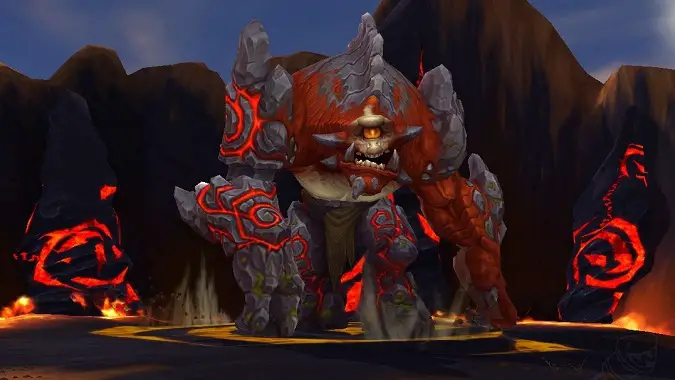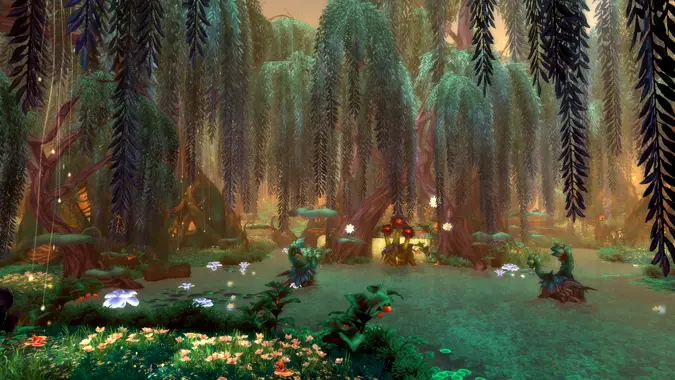Know Your Lore: Children of the Breakers

Last week we discussed the evolution of Draenor – the unique circumstances that led to a world in a constant state of conflict. The Evergrowth, a vast, sentient network of behemoth plants called Sporemounds, threatened to overwhelm the world. Due to the timely intervention of the Titan Aggramar and his creation, Grond, the Evergrowth was eventually defeated…for the most part. But Grond died right along with the Sporemounds, and left behind a new, unique strain of life in his wake.
Please note: Today’s Know Your Lore will be discussing events and history presented in Chronicle Volume 2. While all of this is ancient history, those wanting to read the book for themselves should probably do so before tackling this column.

Breaking down
Grond was a Titan creation, but he was forged from natural ingredients – Draenor’s largest mountain fused with the energies of an elemental storm. As Grond fought the Sporemounds, great chunks of his weathered body fell, and these became the colossals. Aggramar then crafted stone discs from Grond’s remains and branded these with titan runes of power, fusing them to the bodies of the colossals.
And just as pieces of Grond broke off and created the colossals as he fought the sporemounds, the same happened to Grond’s children. The pieces that split free from the colossals became the mangaron – less intelligent, but still incredibly powerful creatures. But something else happened when the last Sporemound fell. When Botaan detonated, its body released countless spores overflowing with the Spirit of Life.
These spores caused a reaction similar in ways to the Curse of Flesh. They weakened the bodies of some magnaron, essentially devolving the creatures over time into the gronn. And again, over time, some of these gronn continued to devolve, eventually becoming the ogron. Once again the same process occurred, degenerating some of the ogron into ogres. And finally, the last chain of that degenerative process transformed some ogres into the creatures we call orcs.
With each generational shift, the newly created species was smaller, yes, less powerful – but increasingly more intelligent. The magnaron, gronn, and ogron continued to thrive and live on as the breakers, but their descendants would one day vastly outnumber them.

Echo of the Evergrowth
Although Botaan’s spores weakened the magnaron, they had the opposite effect on Draenor’s plant life. New species of sentient plant life began to spring up in Draenor’s jungles, from the simpleminded sporelings and podlings to the far more intelligent botani. And the genesaur – lingering remnants of seeds and roots from the three original Sporemounds – continued to walk Draenor’s surface as well. These creatures were the primals – powerful, primal remnants of the overgrowth that once dominated Draenor.
And with the Evergrowth gone, Draenor’s animal life began anew, no longer choked out by the crush of sentient plant life. But it too was affected by the spores and the Spirit of Life, evolving into giant beasts that actually wielded power over the land. Most of these creatures were summarily hunted by both breaker and primal alike. But some managed to flourish – mainly the winged creatures that were able to soar far above the reach of any who sought to infest or devour.
Here’s the interesting part about Draenor’s evolution – Aggramar left the colossals with a single command: Defeat the Evergrowth. He never returned to give them another command. To this day, the breakers continue to fight the primals when they encounter them, despite their perceived unintelligence. It’s as if Aggramar’s command was ingrained somewhere in the genetic makeup of every colossal descendant – an instinct that they could never truly ignore.

Children of Stone
Where does that leave the children of stone? Unlike the colossals that combined their efforts to bring down the final Sporemound, their descendants spent most of their time fighting. If they weren’t fighting the flora of the world for survival, they were fighting each other. And if they weren’t fighting each other, they were fighting among themselves, clan against clan. Maybe Aggramar’s command faltered here – instead of “defeat the Evergrowth,” they were left with “defeat.” Fight, defeat, conquer, and survive.
The orcs are perhaps the most interesting branch to come out of all of this. They weren’t natives of Draenor in the sense that we’d recognize – they were titanforged, as much as the humans of Azeroth once were. Trace back their lineage and you’ll eventually come to Draenor’s largest mountain – fused with the energies of an elemental storm.
The remnants of Grond, way back in the time of his defeat, weren’t just rock and stone – they also contained that elemental debris. For the first time ever, elemental spirits were able to take physical form on Draenor. The most powerful of these were the Elemental Furies. Is it any wonder, then, that the orcs – descendants of this lineage – would eventually embrace and welcome those same spirits, becoming Shaman?

Draenor vs. Azeroth
Draenor never had a world-soul. But its denizens proved to be powerful in their own right, largely due to the influence of a single Titan. One wonders if this accounts for part of the potential Kil’jaeden eventually saw in the Orcish race – or why Sargeras decided to bring them to Azeroth in the first place. Use the descendants of Aggramar’s final creation to bring down the world that Aggramar had so valiantly tried to use to sway Sargeras’ mind? There’s a certain amount of cruel irony in that.
Along those lines, one also wonders if the success of the Orcs on Azeroth was due to that long-ago Titan influence. The elements of Azeroth are far more chaotic than those on Draenor, but they recognize a child of the elements no matter where they hail from. And even though they hail from an entirely different planet, the Orcs fight alongside the rest of Azeroth’s races to protect it. Is this simply wanting to keep their home intact this time, or because there’s some innate primal instinct at play here?
Regardless, the curious lineage of Draenor’s races sheds a lot of light on the world and why, exactly, it’s so riddled with conflict. Conflict shaped the continents as we know them – we walk on the corpses of behemoths that fought in ages long past. Their descendants display the same kind of aggression because they know nothing else. It’s how they were created. Like it or not, fighting is in their blood.
It almost makes me wonder what Draenor would’ve looked like had Aggramar eventually returned. Would he have called off the fighting? Shaped the world even further? Would the use of magic have evolved in a different way? We’ll never really know. Draenor’s turbulent past and Aggramar’s demise eventually led the world to what we know it as today – a shattered husk of ruined potential. An Outland, shattered and strewn across the skies.
Next week, we’ll explore the history of Draenor’s avian natives – the gods of Arak and their children, the arakkoa.
Please consider supporting our Patreon!
Join the Discussion
Blizzard Watch is a safe space for all readers. By leaving comments on this site you agree to follow our commenting and community guidelines.
 @Shadesogrey
@Shadesogrey




